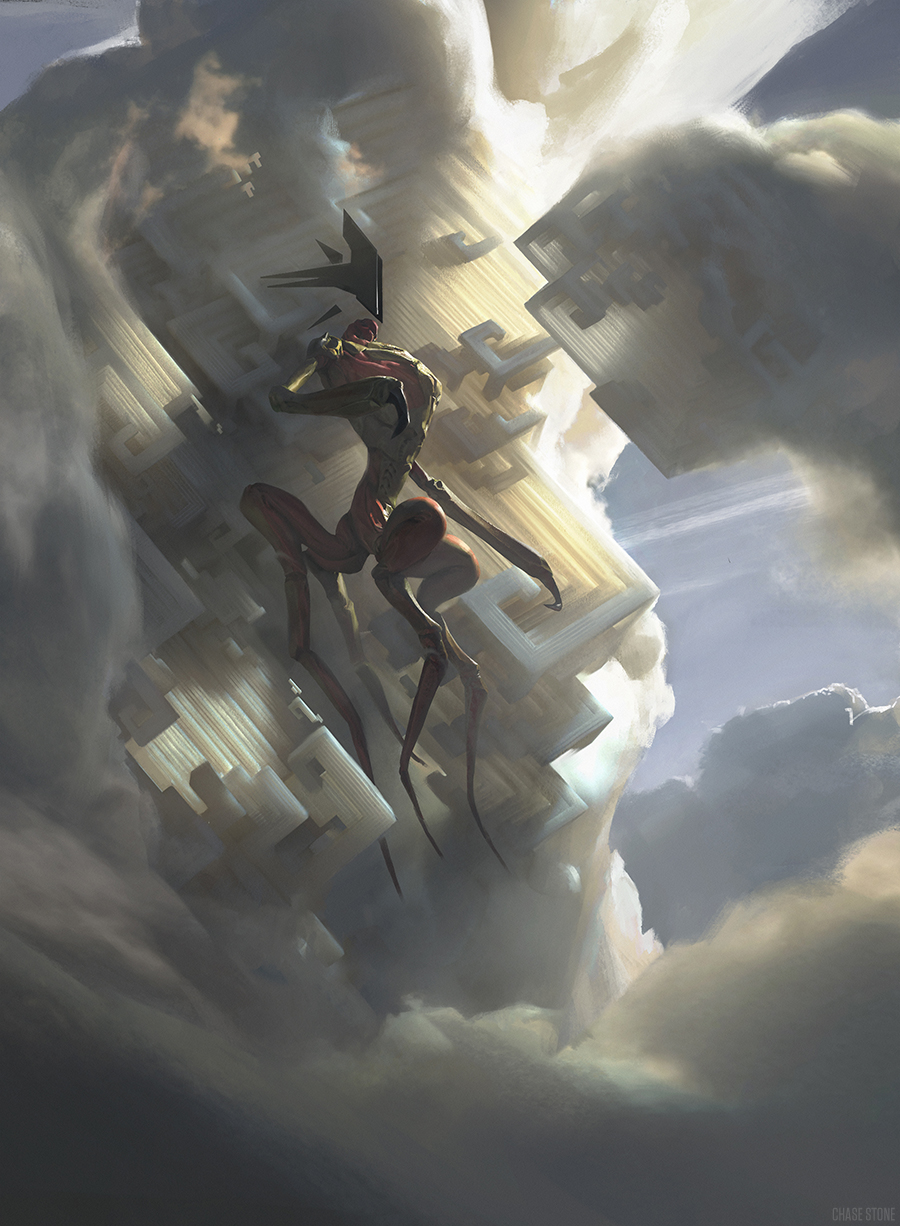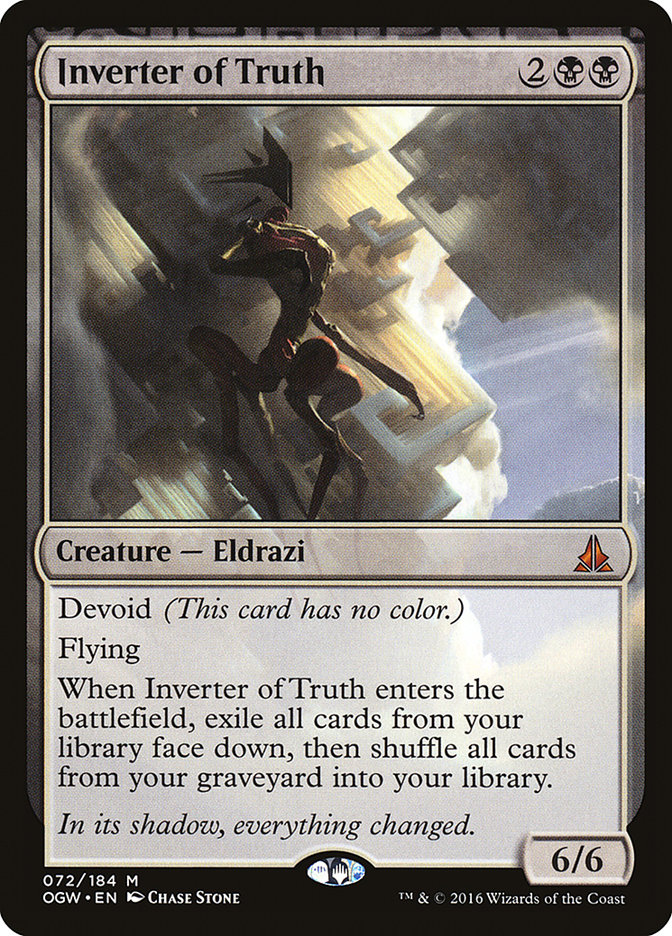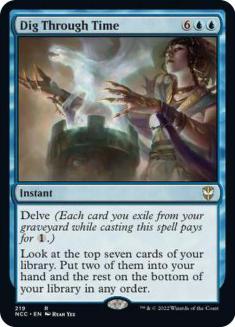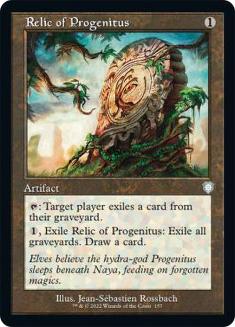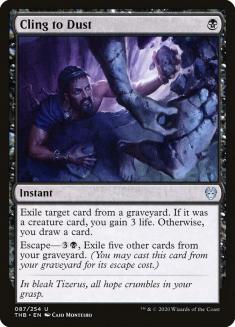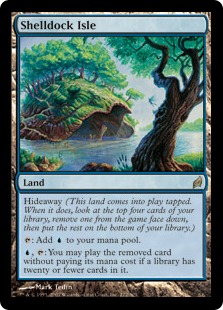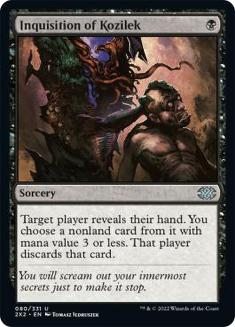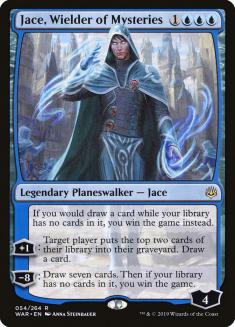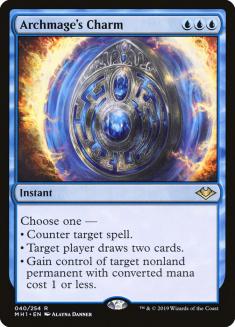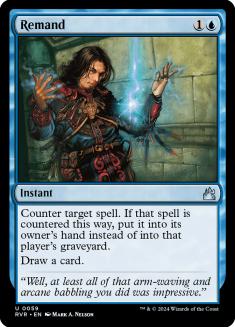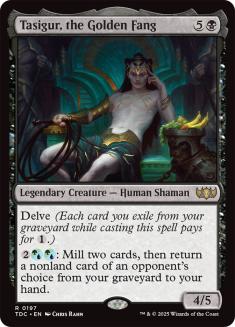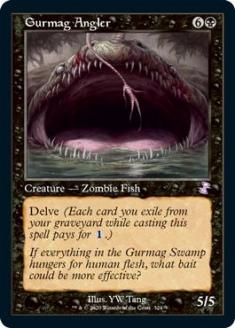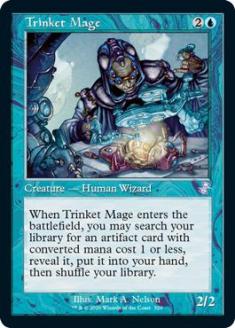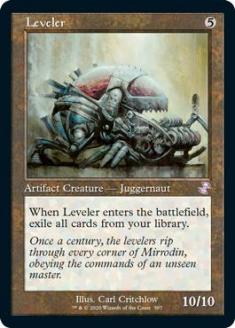Combo decks are nothing new to Modern.
When you sign up for a Modern tournament, there’s a very good chance that your first opponent will be running some sort of infinite or game-ending combo in their deck, even if most of their plan is to play fair. Two-card combos exist pretty widely in the Modern ecosystem but most of the time those combos force you to build your entire deck in a very specific way.
When someone’s whole deck is dedicated to assembling that combo kill, it usually comes at the expense of being able to interact or win the game in some non-linear fashion. Every now and then, a combo deck will come along that breaks that parity, allowing the pilot to shift seemlessly between combo and control. Any combo deck that gets to play a ton of interaction is always worth a second look, and especially so when that combo has been dominant in another format.
Inverter of Truth played a lot like Splinter Twin when it was in Pioneer. While the Pioneer format isn’t as degenerate as Modern, there was a time where the top three or four strategies all had some combo-style finish. Personally, I was not a fan of playing with or against Dimir Inverter. The tools don’t exist in Pioneer to interact in enough ways to make the games interesting from the opponent’s perspective. From my side of things, all I see is them killing a few creatures, hitting me with discard spells, and eventually using Dig Through Time to eat their graveyard and find their combo pieces.
The printing of Thassa’s Oracle put Inverter of Truth on the map. The fact that you can kill it with the trigger on the stack and still lose made it frustrating to interact with in any a lot of ways. At some point it became clear that it was the best deck in Pioneer, but the prevalence of combo in the format forced Wizards of the Coast’s (WotC’s) hand to clean house. Not only did Inverter of Truth get the hammer, but a number of other combo-centric cards got tagged as well. We’ve seen a few of those combos make their way into Modern already, like Heliod, Sun-Crowed + Walking Ballista, so what’s stopping Inverter of Truth from becoming the next Splinter Twin?
I’d argue that Dig Through Time was one of the most important parts of Dimir Inverter in Pioneer, but it’s banned in Modern due to the interaction with fetchlands. Missing that burst of card advantage, card selection, and the smooth graveyard removal to make Inverter of Truth more consistent is a huge deal, but therein lies the oyster. We must find a way to pluck the pearl from it, even if we lost one of our better tools. Eating the graveyard is important here, as it’s one of the easier ways to make Inverter of Truth into something Doomsday-adjacent. The double dip with Dig Through Time just made it ludicrous in the deck.
If you’re unaware of how the combo works, let’s do a quick recap:
- Make sure your graveyard has very few cards in it, and then cast Inverter of Truth. Flip your graveyard into your library.
- Cast Thassa’s Oracle or Jace, Wielder of Mysteries and “deck” yourself, thereby winning the game with their individual alternate win clauses.
The hard part of playing this deck will be exiling or controlling the size of your graveyard. Dig Through Time was such a big part of the archetype that it’s hard to understand just how big the hole is to fill. With that said, the combo is still strong and playing cards that incidentally remove your graveyard and are also “just pretty good on their own” can feel painless.
I’ve long thought that people didn’t play enough maindeck graveyard interaction. Merfolk used to play it in Legacy, which randomly gave them some pretty solid percentages against decks that were too reliant on the graveyard. Imagine playing Dredge or something and your opponent just leads with Relic of Progenitus on the first turn on the play. Do you think you’re ever winning that game?
Cling to Dust does an okay job of playing a similar role, but also generates some raw card advantage alongside micro interaction as the game progresses. I think of Cling to Dust like a Think Twice that can hit the opponent’s graveyard. In this deck, it doubles as a way to remove your own graveyard, but it’s clunky. Regardless, you need some way to remove your own graveyard so your combo actually works. What spells you choose to do that can vary, but I’m digging Relic of Progenitus and some form of delve or escape.
It’s only fitting that the person who put Dimir Inverter on the map in the first place in Pioneer was the inspiration for this article. Without further ado, here’s Piotr Glogowski’s Dimir Inverter for Modern.
Creatures (8)
Planeswalkers (3)
Lands (23)
Spells (26)

As a rough draft, there’s a ton to love about this archetype. Glogowski (aka kanister) is really showing off here, reminding us why he’s one of the more prolific deckbuilders in the world. Each card makes a lot of sense as to why it’s there, so my goal is to break each one down and explain its relevance. As we go, I’ll discuss alternatives, as well as different ways we can build the archetype. Since it’s so early in the deck’s lifespan, in a format as big and robust as Modern, it will take some time to figure out the optimal build. So let’s get to work!
Before we get into the nitty-gritty, I wanted to discuss one of the biggest upgrades for the deck, and one of the reasons why I’m drawn to the archetype in the first place.
I’ve seen Shelldock Isle do some dirty stuff over the years. In Cube, it’s one of my favorite lands to pick up, as it turns on without much help around the tenth turn of the game. When you hit that point, a land that casts one of the best spells from among four looks is damn solid. When you combine it with some deck-shredding effect, like Doomsday or Inverter of Truth, it becomes a lot more threatening in a significantly faster way.
Shelldock Isle can do double duty, acting as card advantage or a combo piece. Casting Inverter on four mana with a Shelldock Isle holding Thassa’s Oracle also means you can combo-kill on your own upkeep before you get decked, assuming you get the timing right (and your opponent doesn’t have a Field of Ruin). It’s one of the coolest lands you can ask for in a deck like this one. The only downside is that it enters the battlefield tapped.
As we churn through the spells from here on out, I’ll be talking about their roles in the deck and some things we can potentially play instead. There’s nothing in the game currently that can take the place of Shelldock Isle. If you play less than four, it has to be because you can’t afford to draw two. The whole point is to slow the game down enough so that Shelldock Isle becomes outrageous.
The Interaction
The best part about Dimir Inverter is its ability to dictate the pace of the game. With so much cheap interaction, you get to slow the game down when you need to. When it comes to combo decks, those that can play the control role are terrifying because the way the games vary wildly. Your modes of interaction can be lights-out for something like Storm or whatever, but a deck like Dimir Inverter can put ten or so cards in the graveyard and just slam a 6/6 flyer. It might not always get the job done, but it’s a combo piece that also acts as a threat if your graveyard is big enough. I lost to Inverter attacking enough times in Pioneer to understand just how threatening the body can be. As someone who’s gotten in plenty of damage with Deceiver Exarch and Pestermite, a giant flying trampler seems pretty solid in retrospect.
The interaction is the part of the deck that gives me goosebumps. Combo decks shouldn’t be fast or consistent without giving up a lot of deckbuilding real estate. When something comes along that sacrifices very few slots for a combo while playing and regularly winning normal games of Magic, you’ve got a winner on your hands. Let’s talk about what cards facilitate that terrifying gameplan.
Fatal Push has become ubiquitous within black decks. With or without fetchlands, Fatal Push has become the de facto removal spell for any deck playing black where it’s legal. When you boil it all down, one mana to kill four-mana or smaller creatures is about as good as it gets. It’s such a breath of fresh air to get this kind of effect outside of Path to Exile, one of my most reviled pieces of interaction that sees massive play in the format. If I can lean black in any deck over white, I try to, if only because it allows me to play Fatal Push instead of anything I’d deem worse.
Some number of Thoughtseize and Inquisition of Kozilek have been stock in midrange black decks for a very long time. Inquisition of Kozilek has become the “better” of the two, but I think that choice ultimately comes down to whether or not your deck can easily take two damage and keep on truckin’. When your spells deal you a ton of damage, that makes your life a lot more difficult against Burn or other aggressive decks. Inquisition of Kozilek tags enough stuff in the zero-to-three range that it shines in Modern over Thoughtseize in more archetypes.
Death’s Shadow might be the only deck in the format that wants four copies of Thoughtseize before any number of Inquisition of Kozilek. They’re both good, and the occasional four-mana spell or control deck will make you wish you were leaning Thoughtseize, but some combination of these two is probably more right than only playing four total copies of discard.
The draw of these discard spells in Dimir Inverter is three-fold:
- Disrupt the opponent. If your opponent is playing a linear strategy, stripping them of one piece could severely hinder their development or overarching gameplan. In Modern, disrupting the opponent is usually a worthwhile endeavor.
- Protect the combo. Some opponents will be interacting with you via counterspells or other means. If they’re sitting on their hands, having a piece of proactive disruption can come in clutch. Mystical Dispute or Cryptic Command are hard for combo decks to play through on occasion, which makes the prospect of having Thoughtseize very appealing.
- Slow the game down. This combo isn’t as easy to assemble as Splinter Twin. You can’t just cast a three-mana card into a four-mana card and win the game. Thoughtseize can buy you a lot of time, even if it does deal you a few points of damage. Inquisition of Kozilek coming down early can take your opponent’s only drop of a certain mana cost, which causes them to stumble or lack the necessary pressure to close the game out. Discard is tempo-negative in that it costs mana to trade one spell for one spell, but the card you take often bottlenecks the opponent in some way.
Another potential build from kanister featured more control elements than the previous version.
Creatures (8)
Planeswalkers (2)
Lands (20)
Spells (30)

When Dark Depths Thopter (DDT) was the best deck in Extended, the original versions revolved around the combo almost completely. Thoughtseize was solid at doing all the things we’ve already discussed, but most of your games were won on the back of making a Marit Lage token as quickly as possible. As the format evolved, so did the deck.
Winning the game by alternative means after slowing stuff down is exactly what you have to do in the face of extreme interaction. If your opponent is hitting you with discard, counters, or other forms of disruption (but aren’t necessarily putting a lot of pressure on you), having some sort of extra engine to throw a wrench in the works is disgusting. Luckily, one of our combo pieces acts as a card advantage engine already!
It’s incredible how powerful “draw an extra card every turn” can be with no other text. Jace, Wielder of Mysteries offers that alongside a two-card kill. The draw effect means we can cast it on a dry battlefield and start building resources. The fact that it can sit on the battlefield also gives us some breathing room as far as assembling our combo is concerned. Eight mana over two turns with Inverter and Jace is a lot, so any time you can safely cast Jace and ride it for a turn or two while you continue setting up is rad.
Jace, Wielder of Mysteries is also a win condition on its own. Alongside removal and other cheap interaction, it shouldn’t be hard to bury your opponent. Winning with any planeswalker ultimate should be simple. Jace, Wielder of Mysteries acting as that draw engine as a freeroll addition to the archetype is, quite frankly, ludicrous.
Archmage’s Charm might be my favorite spell from Modern Horizons. I love the versatility, as all three modes are solid at three mana. The downside is that, on occasion, your mana is awkward or it just costs too much. Three mana is a lot when it comes to Modern, so you need that three-mana spell to do exactly what you need it to do on the turn when you can cast it.
As Cancel, it’s excellent. When you have control of the battlefield, holding it to use as a counterspell really squeezes your grip on the game. When you’re behind, cards like Cancel are horrific because they can’t interact with what’s already on the battlefield. That’s where the versatility comes in. Being able to cycle it while picking up an extra card is excellent, and exactly what I want my three-mana counterspell to do! The third mode is icing, yet comes up often enough that it warrants talking about. I steal Aether Vial, Noble Hierarch, and Monastery Swiftspear on the regular.
Archmage’s Charm locks this build firmly into the camp of combo-control instead of straight combo. That’s the sweet spot where I want to be and where this archetype should thrive.
Remand is one of my favorite cards in Magic, but I’ve been burned by it in Modern more than a few times. When the format is low to the ground, Remand is the absolute worst form of interaction. It doesn’t meaningfully deal with the problem in any way, and only offers a replacement effect and a small amount of time. When Remand is hitting one-mana spells regularly, it’s bad. If you find yourself tagging twos and threes, that’s on the money.
At the moment, it seems like the format is starting to open up, regularly featuring creatures and decks that span a wide range of casting costs. I’m definitely on board with Remand in this deck, as it is one of the better forms of interaction for combo-control. That type of deflation of your opponent’s turn coupled with digging for your combo is hard to find. As you add more instant-speed spells like Archmage’s Charm, Remand becomes a bit better, though its utility is entirely dependent on the average casting cost of your collective opponents’ spells.
Delving for Secrets
As you can see in these lists, there are a few delve spells. These can exile your graveyard for Inverter while generating mana advantage via cost reduction. Like many of the spells in your deck, they’re working overtime. That makes me think we should potentially move in a different direction. I started to have a lot of success with Splinter Twin when I combined it with an aggressive plan.
You see one of these in the sideboard as a way to generate pressure against a slower opponent while adding more ways to exile your graveyard. But that had me thinkin’… what if we just played a few in the maindeck? I don’t think we need too many ways to fuel the graveyard, as casting something like Tasigur, the Golden Fang should be trivial if we don’t fully pop our Relic of Progenitus too early.
One problem with this plan is that it might end up making the deck a little too split. Thassa’s Oracle isn’t exactly known for beating down, but I’ve done stranger things with a weirder set of creatures. Desperate times call for desperate measures and all that.
Creatures (14)
- 2 Grim Lavamancer
- 3 Pestermite
- 1 Vendilion Clique
- 1 Deceiver Exarch
- 4 Snapcaster Mage
- 3 Tasigur, the Golden Fang
Lands (18)
Spells (28)

If you compare this list to the “normal” Splinter Twin decks, you’ll see that my emphasis on the combo is negligible. Of course, Pestermite can combine with Splinter Twin to make infinite Faeries, but most of the games were won on the back of Lightning Bolt and Snapcaster Mage. Tasigur was my pick at the time but I’m not confident that it was better than Gurmag Angler. This was just weeks after the release of Fate Reforged, so we were in the midst of exploring all the delve cards in the wake of Treasure Cruise and Dig Through Time being banned.
All this is to say that it might not be all that hard to turn Dimir Inverter into something entirely different. The original iterations produced by kanister are cool as hell, but there has to be something else we can do inside this shell. There’s too much wiggle room, and I’m not impressed enough by the current supporting cast. Cling to Dust stinks, and I’m confident I can work some copies of Snapcaster Mage into the mix. At the very worst, we can play a deck that has various combo kills but also gets to play Inverter of Truth as a giant four-drop after a few copies of Thought Scour or the like.
Creatures (17)
Planeswalkers (2)
Lands (20)
Spells (21)
Sideboard

This build is entirely experimental, but one I hope to build upon in the near future. Using delve creatures to functionally create room for the Inverter combo is pretty cool, really giving the vibes that you’re using all parts of virtually every card. We need to maintain some balance between the combo and the fair gameplay, and finding that balance just takes time.
I think this build might suffer from trying to do too much at once, but if it ends up working a few times, I’ll know there’s something here. Not playing Relic of Progenitus or any other ways to exile your graveyard other than the delve creatures is a bit scary, but ultimately I think they’re strong enough. If there were some delve spell that drew cards, maybe we would consider that instead.
I’d like to find a way to play Trinket Mage, since it grabs Relic of Progenitus and Engineered Explosives — two powerful cards that can both do some cool stuff in this shell. Trinket Mage itself isn’t that impressive, but a tutor that comes with a body is always cool. Trinket Mage suffered from the Mox Opal banning, but maybe this is the type of deck that brings it back! No matter how you build it, the core of Inverter of Truth, Shelldock Isle, and Thassa’s Oracle can fit into many shells. If you want to max out on this type of effect, you can even play Leveler!
In conclusion, when a new archetype is presented to us in a mostly solved format, trying out all sorts of toys should be the norm. We should be pushing Dimir Inverter to the limit because it’s already proven it has legs in a short period. The loss of Dig Through Time in transition from Pioneer to Modern was a big one, but the core is strong and the supporting cast is flexible. Hell, we could even branch out and play another color! I’ve been a longtime proponent of Grixis in all shapes and sizes, and an aggressive slant could mean playing Lightning Bolt. However, four copies of Shelldock Isle is basically impossible in a three-color deck without balancing your spells around your mana instead of the other way around.
If you’ve been pawing at old copies of Inverter of Truth like Wolverine looking at a picture of Jean Grey after it got banned in Pioneer, pick this deck up. It’s cool as hell, offers unique gameplay patterns, and sits at just the right power level for Modern. I wasn’t a fan in Pioneer, but Modern feels like home for this deck.

